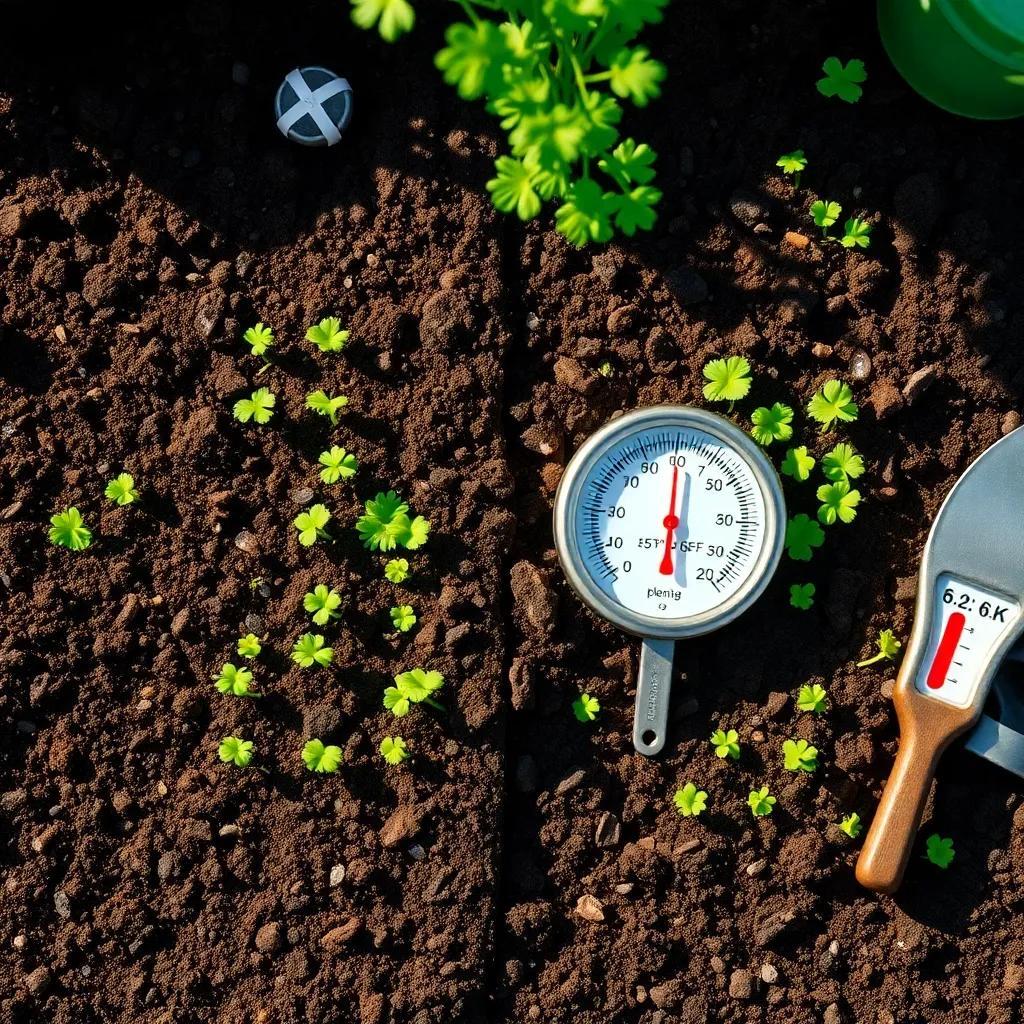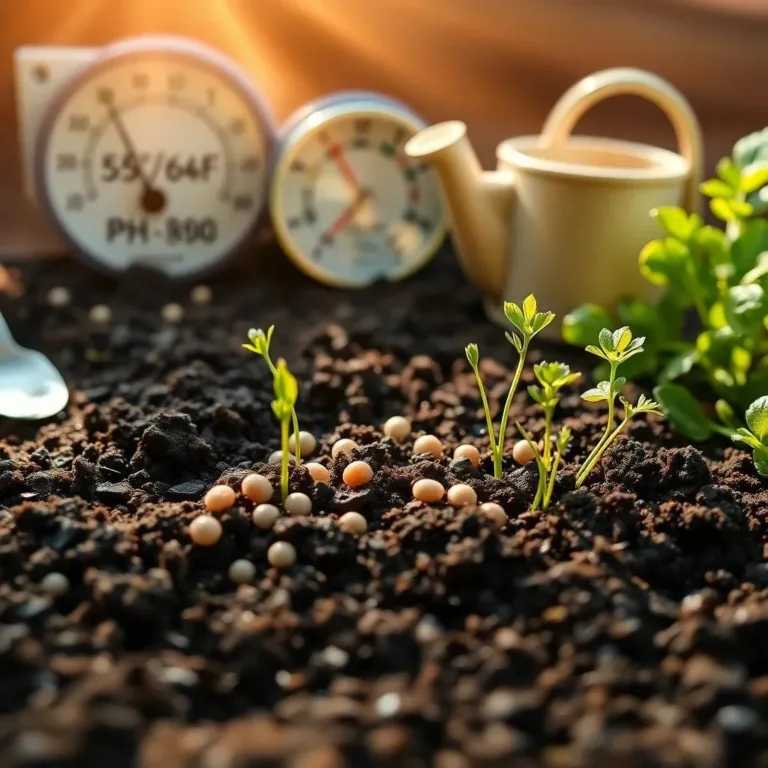Are you curious about how to grow your very own coriander? Join me on this fun gardening adventure where I’ll share everything you need to know about getting those seeds to sprout! From understanding what helps them germinate to tackling pesky problems along the way, we’re in for a flavorful journey together! Let’s dig in! 🌱
Factors Influencing Coriander Seed Germination
When I plant my coriander seeds, I often wonder what really helps them sprout and grow into those lovely, fragrant plants! There are several factors that play a significant role in the germination process. By paying attention to these, I can make sure my seeds have the best chance to thrive!
- Temperature: Getting the temperature just right is super important! Coriander seeds love a cozy spot between 55°F and 68°F (13°C to 20°C). If it’s too cold, they might take their sweet time to sprout. But if it’s too warm, they could struggle and not develop properly! It’s like trying to bake a cake—you want the heat just right!
- Moisture: My seeds need a Goldilocks amount of moisture—not too much and not too little! Keeping the soil consistently moist is key. Overwatering can lead to root rot, so I always check that the soil isn’t saturated. A little sprinkle here and there does the trick!
- Light: Here’s a fun fact: coriander seeds don’t need light to germinate! They actually prefer a dark place while they’re sprouting. I like to cover them lightly with soil, so they have the darkness they crave. Once they peep out, though, it’s time to bask in the sunshine!
- Seed Quality: If I want my coriander to thrive, I make sure to start with high-quality seeds. Old or poorly stored seeds often don’t sprout. So, I always check for freshness when I buy!
- Soil Preparation: The right soil can make all the difference! I opt for well-draining soil that’s rich in organic matter. A crumbly soil allows roots to dig in and grow strong, which is what we want!
By keeping these factors in mind, I can create a beautiful home for my coriander seeds to flourish!
Ideal Conditions for Successful Germination
Creating the perfect environment for my coriander seeds feels like setting the stage for a grand performance! If I want my seeds to do well, I need to make sure they have the ideal conditions. Here’s what I keep in mind:
- Temperature Control: Like I mentioned before, the perfect temperature is between 55°F and 68°F. I love using a thermometer to check my soil temperature! If it’s too chill, I might put a heat mat underneath. A warm hug goes a long way!
- Moisture Management: Maintaining moisture is a balancing act. I check the soil daily and give it a light sprinkle if it seems dry. I want it to feel like a damp sponge, not a soggy mess. This helps prevent diseases that hate wet conditions!
- Soil Type: Well-draining soil is my best friend. It helps avoid water pooling around the seeds, which can lead to rot. I mix in some compost to provide nutrients, and I might even add sand for extra drainage. It’s like giving my seeds a nutrient-packed bed to relax in!
- pH Level: I keep an eye on the pH level, too. Coriander prefers a pH between 6.2 and 6.8. Testing my soil with a simple kit can make sure I’m in that sweet spot.
- Planting Depth: I like to plant my coriander seeds about 0.6 to 1.3 cm deep. If they’re too shallow, they might dry out. But too deep? Well, it can be a struggle for those little guys to break through!
By providing these ideal conditions, I feel like a proud gardener setting my coriander up for success. I can’t wait to see those little seedlings pop up and flourish! 🌱

Average Germination Time for Coriander Seeds
Ah, the waiting game! When I plant my coriander seeds, one of the first questions I ask is, “How long will it take for these little guys to sprout?” Well, the average germination time for coriander seeds usually ranges from 7 to 21 days. That’s right, it’s quite a bit of variety!
Several factors can influence this timeline, including:
- Temperature: If my seeds are cozy at the ideal temperature of 55°F to 68°F, they’re likely to sprout faster. On the other hand, cooler temperatures may stretch out that 21-day wait.
- Moisture Levels: Keeping the soil just right, not too dry, and not too soggy can definitely speed things up! If the soil is too dry, my seeds might take their sweet time or even fail to sprout altogether.
- Seed Quality: Fresh seeds are like a turbo boost for germination! Older seeds may take longer or not sprout at all, so selecting high-quality seeds can make a big difference.
As I watch over my little coriander garden, I remind myself to be patient. Different seeds may sprout at different times. I like to peek under the soil every few days, wondering if today’s the day! Watching my plants emerge is always an exciting moment, and it’s well worth the wait. Just remember that some seeds are overachievers, popping up early, while others like to take their time.
Tips for Enhancing Germination Success
Now, let’s talk about how to enhance germination success for coriander seeds! With a few easy tips, I can boost the chances of my seeds sprouting like champions. Here’s what I do:
- Choose Quality Seeds: I always start with fresh, high-quality seeds. It’s like picking the best ingredients for a recipe! A good seed can lead to a successful harvest.
- Pre-soak Seeds: Sometimes, I soak my coriander seeds in water for about 24 hours before planting. Doing this softens the seed coat and helps with quicker germination. It’s like giving my seeds a nice warm bath!
- Proper Planting Depth: I make sure to plant my seeds at the right depth—about 0.6 to 1.3 cm. If they’re too shallow, they might dry out, and if they’re too deep, they can struggle to break through. It’s all about balance!
- Consistent Moisture: I check the soil daily to keep it evenly moist. Watering gently helps avoid displacing the seeds. I feel like a plant whisperer, making sure they’re comfy!
- Provide Adequate Light: Once my seedlings pop up, I gradually introduce them to sunlight. They thrive with about 6 to 8 hours of light per day. Too much sunlight at once can be overwhelming!
With these tips in my gardening arsenal, I feel ready for success. I keep an enthusiastic eye on my plants, and I can’t wait to see them flourish!
Common Issues and Solutions During Germination
Despite my best efforts, sometimes things don’t go as planned when growing coriander. But don’t worry! I’ve learned to troubleshoot common issues that may arise during the germination process. Here are some things to watch for, along with my favorite solutions:
- Poor Germination Rates: If my seeds aren’t sprouting well, I double-check the quality of the seeds. Using old or improperly stored seeds can lead to disappointing results. If I see that a few seeds have sprouted, I remind myself that sometimes, nature takes its time!
- Fungal Diseases: Excess moisture can lead to nasty fungal problems like damping-off. To avoid this, I make sure not to overwater and ensure good air circulation. If I spot any fungi, I can sprinkle a little fungicide and keep my plants healthy.
- Seedling Legginess: If my seedlings start getting tall and stretchy, they may not be getting enough light. I can reposition them closer to a sunny spot or use grow lights to help them grow strong and sturdy!
- Insect Pests: Occasionally, I find pesky pests munching on my seedlings. Regular checks help me catch them early! If I notice any, I use organic pest control methods to keep them at bay.
By keeping an eye out for these common issues and addressing them promptly, I can keep my coriander garden thriving. Each day brings new challenges and rewards, and I love the journey of growing my own herbs! 🌿

